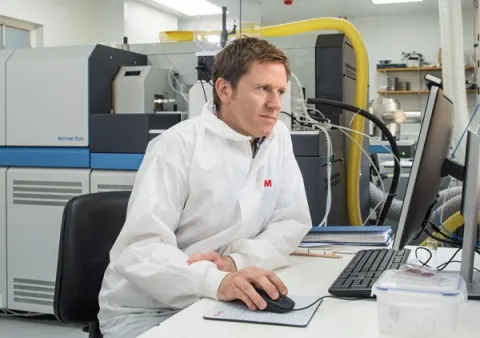Project overview
Today there is a major ice sheet on Antarctica, but this was not always the case. The Antarctic ice sheet formed around 34 million years ago, ushering in the dawn of the "icehouse world". Over the next 11 million years, the climate swung between cooler and warmer states, with sea level falling and rising as ice sheets grew and collapsed. To simulate changes in sea level and climate of this size, computer models require massive fluctuations in CO2. However, we have no evidence of CO2 change of this magnitude, and little idea of how such changes could be accomplished. Furthermore, the existing CO2 reconstructions from this time interval present another major puzzle, as they show a long-term decrease, which appears to be decoupled from long-term climate. These mysterious interactions between CO2, climate, and ice sheets are the "Oligocene icehouse conundrum" that this project aims to solve.
Past changes in climate can be reconstructed using chemical fingerprints in fossil shells of foraminifera - sand-sized organisms that live throughout the ocean - the chemistry of these organisms records the environmental conditions at the time they grew, allowing us to reconstruct how environments have changed in the past. The main reason the climate of the Oligocene (~34-23 million years ago) remains such a mystery is because of a previous lack of sedimentary material containing well-preserved foraminifera from this time interval. Previously acquired records are sparse or biased by poor preservation, leaving us with a limited and confused understanding of how the Oligocene climate system operates.
Now, for the first time, we have identified sites with abundant and well-preserved foraminifera, thus overcoming a major obstacle in Oligocene climate reconstruction. We will analyse foraminifera to reconstruct critical aspects of the Oligocene climate, such as the temperature, global ice volume, sea level, ocean acidity (pH), atmospheric carbon dioxide and the strength of the biological pump. These kinds of analyses are increasingly used to help determine both how climate has changed in the past and how it might change in the future, including "climate sensitivity", the amount of warming expected due to rising CO2.
We have built a team and strategy that poises the project for success. Principal Investigator (PI) Wade is one of the world's foremost experts on the foraminifera of the Oligocene, and so is perfectly placed to figure out which species best record temperatures and atmospheric CO2. Having identified the best species and sites, we will make the first reconstructions of CO2 from this time using the chemistry of boron. This exciting method has seen extensive development in recent years by Co-PI Rae and Co-Investigator Foster, and we will apply the latest methods to determine past pH and CO2. To explore why CO2 may have changed, we will create new records of the biological pump of carbon to the deep ocean. And to evaluate the impact of CO2 on global climate, we will make new records of temperature, using foraminifera and organic molecules, and sea level, using foraminifera from the sea floor. Armed with these new reconstructions of key components of Oligocene climate, we will use a variety of modelling approaches to integrate and interpret them in a global context. A model of how carbon cycles between different reservoirs will allow us to test mechanisms of CO2 change. Simulations of physical climate and ice sheets will be combined in an exciting new way to explore the stability of major ice sheets. We will transform the understanding of CO2 and climate change in the Oligocene, providing insights into the fundamentals of climate sensitivity and ice sheet stability.
The new understanding of Oligocene climate and the carbon cycle that will result from our research will resolve the longstanding Oligocene icehouse conundrum and improve understanding of climate and ice sheet sensitivity in a warmer world.
Past changes in climate can be reconstructed using chemical fingerprints in fossil shells of foraminifera - sand-sized organisms that live throughout the ocean - the chemistry of these organisms records the environmental conditions at the time they grew, allowing us to reconstruct how environments have changed in the past. The main reason the climate of the Oligocene (~34-23 million years ago) remains such a mystery is because of a previous lack of sedimentary material containing well-preserved foraminifera from this time interval. Previously acquired records are sparse or biased by poor preservation, leaving us with a limited and confused understanding of how the Oligocene climate system operates.
Now, for the first time, we have identified sites with abundant and well-preserved foraminifera, thus overcoming a major obstacle in Oligocene climate reconstruction. We will analyse foraminifera to reconstruct critical aspects of the Oligocene climate, such as the temperature, global ice volume, sea level, ocean acidity (pH), atmospheric carbon dioxide and the strength of the biological pump. These kinds of analyses are increasingly used to help determine both how climate has changed in the past and how it might change in the future, including "climate sensitivity", the amount of warming expected due to rising CO2.
We have built a team and strategy that poises the project for success. Principal Investigator (PI) Wade is one of the world's foremost experts on the foraminifera of the Oligocene, and so is perfectly placed to figure out which species best record temperatures and atmospheric CO2. Having identified the best species and sites, we will make the first reconstructions of CO2 from this time using the chemistry of boron. This exciting method has seen extensive development in recent years by Co-PI Rae and Co-Investigator Foster, and we will apply the latest methods to determine past pH and CO2. To explore why CO2 may have changed, we will create new records of the biological pump of carbon to the deep ocean. And to evaluate the impact of CO2 on global climate, we will make new records of temperature, using foraminifera and organic molecules, and sea level, using foraminifera from the sea floor. Armed with these new reconstructions of key components of Oligocene climate, we will use a variety of modelling approaches to integrate and interpret them in a global context. A model of how carbon cycles between different reservoirs will allow us to test mechanisms of CO2 change. Simulations of physical climate and ice sheets will be combined in an exciting new way to explore the stability of major ice sheets. We will transform the understanding of CO2 and climate change in the Oligocene, providing insights into the fundamentals of climate sensitivity and ice sheet stability.
The new understanding of Oligocene climate and the carbon cycle that will result from our research will resolve the longstanding Oligocene icehouse conundrum and improve understanding of climate and ice sheet sensitivity in a warmer world.
Staff
Lead researchers
Other researchers
Collaborating research institutes, centres and groups
Research outputs
Emily Judd, Jessica E. Tierney, Brian T. Huber, Scott Wing, Daniel J. Lunt, Heather Ford, Gordon Inglis, Erin L. McClymont, Charlotte O'Brien, Ronnakrit Rattanasriampaipong,, Weimin Si, Matthew Staitis, Kaustubh Thirumalai, Eleni Anagnostou, Margot J Cramwinckel, Robin Dawson, David Evans, William Gray, Ethan Grossman, Michael Henehan, Brittany Hupp, Kenneth MacLeod, Lauren O'Connor, Maria Luisa Sanchez Montes, Haijun Song & Yige Zhang,
2022, Scientific Data, 9
Type: article

